- Home
- Diana Wynne Jones
A Tale of Time City
A Tale of Time City Read online
Lost in time
“We started planning two days ago after they met the train and couldn’t find her,” said Sam.
“Two days ago!” Vivian exclaimed. “But I was there today, and so were you!”
“Yes, but you can get to any time you want through a time-lock,” Jonathan said, waving that puzzle away in his most lordly manner. “My father went there and Sam’s father, and so did the Head Librarian and the High Scientist, but they all came back saying Vivian Smith had slipped through them somehow. That was when I thought we had a chance of getting you—her—ourselves. Only you’re the wrong Vivian Smith for some reason—and I still can’t understand it! Sam, we’ve got to think what to do with her.”
“Send her to the Stone Age,” said Sam. “You wouldn’t mind that, would you?” he asked Vivian.
BOOKS BY DIANA WYNNE JONES
The Dalemark Quartet
Cart and Cwidder
Drowned Ammet
The Spellcoats
The Crown of Dalemark
The Chrestomanci Books
Charmed Life
The Magicians of Caprona
Witch Week
The Lives of Christopher Chant
Conrad’s Fate
The Pinhoe Egg
Other Books
Changeover
Wilkins’ Tooth (USA: Witch’s Business)
The Ogre Downstairs
Eight Days of Luke
Dogsbody
Power of Three
Who Got Rid of Angus Flint?
The Four Grannies
The Time of the Ghost
The Homeward Bounders
Archer’s Goon
Fire and Hemlock
Warlock at the Wheel (short stories)
The Skiver’s Guide
The Thirteenth Enchanter
Howl’s Moving Castle
A Tale of Time City
Chair Person
Wild Robert
Hidden Turnings (editor)
Castle in the Air
Black Maria (USA: Aunt Maria)
A Sudden Wild Magic
Yes, Dear (picture book)
Hexwood
Fantasy Stories (editor)
Everard’s Ride (short stories)
Stopping for a Spell (short stories)
The Tough Guide to Fantasyland
Minor Arcana (short stories)
Deep Secret
Believing is Seeing (short stories)
Dark Lord of Derkholm
Puss in Boots (retelling)
Mixed Magics (short stories)
The Year of the Griffin
The Merlin Conspiracy
Unexpected Magics (short stories)
The Game
House of Many Ways
Enchanted Glass
Earwig and the Witch
FIREBIRD
WHERE FANTASY TAKES FLIGHT™
Dogsbody Diana Wynne Jones
Epic Conor Kostick
Fire: Tales of Elemental Spirits Robin McKinley and
Peter Dickinson
Fire and Hemlock Diana Wynne Jones
Firebirds:
An Anthology of Original
Fantasy and Science Fiction Sharyn November, ed.
Firebirds Rising:
An Anthology of Original
Science Fiction and Fantasy Sharyn November, ed.
The Game Diana Wynne Jones
Incarceron Catherine Fisher
Indigara Tanith Lee
Interstellar Pig William Sleator
The Neverending Story Michael Ende
Redwall Brian Jacques
Saga Conor Kostick
Sapphique Catherine Fisher
Singing the Dogstar Blues Alison Goodman
The Starry Rift:
Tales of New Tomorrows Jonathan Strahan, ed.
Tamsin Peter S. Beagle
The Tough Guide to Fantasyland Diana Wynne Jones
Troll’s Eye View:
A Book of Villainous Tales Ellen Datlow and
Terri Windling, eds.
Wolf Tower Tanith Lee
Introduction by Ursula K. Le Guin
FIREBIRD
AN IMPRINT OF PENGUIN GROUP (USA) INC.
FIREBIRD
Published by the Penguin Group
Penguin Group (USA) Inc., 345 Hudson Street, New York, New York 10014, U.S.A.
Penguin Group (Canada), 90 Eglinton Avenue East, Suite 700, Toronto, Ontario, Canada M4P 2Y3
(a division of Pearson Penguin Canada Inc.)
Penguin Books Ltd, 80 Strand, London WC2R 0RL, England
Penguin Ireland, 25 St Stephen’s Green, Dublin 2, Ireland (a division of Penguin Books Ltd)
Penguin Group (Australia), 250 Camberwell Road, Camberwell, Victoria 3124, Australia
(a division of Pearson Australia Group Pty Ltd)
Penguin Books India Pvt Ltd, 11 Community Centre, Panchsheel Park, New Delhi – 110 017, India
Penguin Group (NZ), 67 Apollo Drive, Rosedale, Auckland 0632, New Zealand
(a division of Pearson New Zealand Ltd.)
Penguin Books (South Africa) (Pty) Ltd, 24 Sturdee Avenue, Rosebank, Johannesburg 2196, South Africa
Registered Offices: Penguin Books Ltd, 80 Strand, London WC2R 0RL, England
First published in the United Kingdom by Methuen Children’s Books Ltd, 1987
First published in the United States of America by Greenwillow Books, 1987
Published by Firebird, an imprint of Penguin Group (USA) Inc., 2012
1 3 5 7 9 10 8 6 4 2
Copyright © Diana Wynne Jones, 1987
Introduction copyright © Ursula K. Le Guin, 2012
Excerpt from Fire and Hemlockcopyright © Dianna Wynne Jones, 1985
Excerpt from Dogsbodycopyright © Diana Wynne Jones, 1975
All rights reserved
LIBRARY OF CONGRESS CATALOGING-IN-PUBLICATION DATA IS AVAILABLE
ISBN: 978-1-101-56700-5
Set in Minion
Design by Tony Sahara
Printed in the United States of America
All rights reserved. No part of this book may be reproduced, scanned, or distributed in any printed
or electronic form without permission. Please do not participate in or encourage piracy of
copyrighted materials in violation of the author’s rights. Purchase only authorized editions.
ALWAYS LEARNING
PEARSON
For Tabitha and William
CONTENTS
Introduction by Ursula K. Le Guin
1 Kidnapped
2 Cousin Vivian
3 Time City
4 Time-Ghosts
5 Time-Lock
6 Cousin Marty
7 The River Time
8 Duration
9 Guardian
10 Ceremonies
11 The Age of Gold
12 Android
13 The Gnomon
14 The Age of Silver
15 Evacuees
16 The Lead Casket?
17 Faber John
Introduction
Ursula K. Le Guin
This is a wonderful story of time travel, in which you, the reader, get to travel even farther than Vivian Smith, the heroine. Since you live in the twenty-first century, as soon as you begin reading this book you’ve traveled back in time… to the last century, to the autumn of 1939, the beginning of Hitler’s war. German bombs were falling on London, and schoolchildren were being sent away from the city into the countryside where their parents hoped they might be safe.
Just as Vivian arrives at the train station of the little town where her cousin Marty is supposed to meet her, a strange boy introduces himself as her cousin, grabs her luggage, and hurr
ies her across the station platform and straight through a solid wall.…
Ah, yes, these things were happening, long, long before they ever happened to Harry Potter.
Vivian doesn’t end up at wizard school, but thousands of years into her future (and yours) at Time City, a place that exists outside history. Her being there at all is a mistake. The boy wasn’t her cousin Marty at all. His name is Jonathan, and he’s trying to save Time City from a terrible fate, and he needs Vivian Smith to help him do it. But when he went back in time for her, he got the wrong Vivian Smith.…
Or did he?
The one he found is certainly a courageous and resourceful companion. She’s scared and confused, as who wouldn’t be, getting kidnapped by mistake away from a war into the middle of a disaster. But she bravely faces every adventure and danger to be met in Time City. And it’s a thoroughly dangerous and adventurous place, at least if you insist on doing what Jonathan and his friend Sam are trying to do in order to save the City from the doom that’s coming closer and closer to it every day—the End of Time.
Actually, Sam is more interested in eating butter-pies than in saving the City from doom. Butter-pies are one of the finest inventions of Time City. A butter-pie comes on a stick and has an ice-cold, crunchy, toffee-ish outside, but when you get to the inside, it’s hot. The idea is to mix up the cold crunchy part with the hot syrupy part as you eat it. Vivian learns very quickly to eat butter-pies—although not as many as Sam. Sam is too easily distracted by the very thought of butter-pies. Vivian, however, soon realizes that an unknown enemy wants to prevent Jonathan from saving Time City, and that this enemy is quite ready to leave them all marooned in some strange, lonesome part of history where they don’t belong, and from which Vivian will never be able to get back to the twentieth century where her mother and father are.
One of my favorite parts of the book is where the three of them actually go back in time to the train platform in 1939 to try to put things straight. This time they meet the real Cousin Marty that Vivian was supposed to stay with so she would be safe from Hitler. And Vivian realizes that even though Jonathan has got her into an awful lot of trouble in the Far Future, he may have saved her from something—well, not as bad as Hitler, maybe, but pretty bad.
When they get back to Time City, Doom is coming ever nearer, and terrible things begin happening in history—things that weren’t supposed to happen—such as the invention of nuclear war a whole century too soon.…
In reality we can’t mess around with time, but we can in our imagination, and time-travel stories are a lot of fun. But when you start messing with time, it can get very confusing, and you need a strong imagination, plus a clear head, to keep making sense. This story makes wonderful sense all the way through, even when confusion is at its worst, when everything in history as we know it is changing, and the very foundations of Time City are cracking and crumbling under Vivian’s feet. It’s a complicated story but it doesn’t seem complicated. It’s as straightforwardly exciting as a roller-coaster ride through a hundred centuries.
A Tale of Time City was written and published for young adults. But, like all really good fantasy, it isn’t just for one kind of people, one age group. Fantasy doesn’t care how old you are. Imagination pays no attention to all those walls we put up between the different stages of life; it just breezes right through them. A lot of kids younger than their teens will certainly enjoy this story. And people a long way past their teens can enjoy it just as much. I can guarantee that. I’m ancient, and I went along on the roller-coaster ride whooping and hollering all the way.
Diana Wynne Jones knows how to tell a story. That sounds so simple: “knows how to tell a story.” Maybe it is simple, but it is rare—very rare. Like the gift of music, storytelling is a great gift, and a mysterious one. When you find a writer who has that gift, remember their name. If they told one good story, their other stories may be as good if not better. This is certainly true of Diana Wynne Jones. I think she could have written a story about grass growing, or what sheep think when they’re lying around chewing, or what it’s like to be a rock, and that story would be just like what the blurbs on book covers say: Riveting! Gut-wrenching action! A page-turner! You can’t put it down!
But fantasy stories are a special kind, and they take a special gift. First of all, of course, fantasy takes imagination, but to make a daydream into a story takes a kind of intelligent truthfulness that is, again, quite rare.
A fantasy story doesn’t stick to “the facts” (whatever they are) because not sticking to fact is what makes it a fantasy, okay? So what do I mean by saying it takes truthfulness? Well, in the first place, it has to stick to the “facts” that it makes up. Fantasy invents a world—and then it has to live in that world. It makes up the rules of its world, but it can’t change them. When a writer changes the rules of a fantasy in the middle of it, the story begins to fall apart right there. Things stop making sense. The readers don’t know where they are anymore. It all gets boring and frustrating, exactly the way a game gets boring and frustrating when the players cheat by changing the rules.
Diana Wynne Jones invents brilliant rules for her brilliant invented worlds full of realistic impossible marvels—and she never, ever cheats on them.
And there’s another kind of truthfulness every storyteller needs, which is moral honesty. It seems that, because the writer gets to make up the rules, all the rules in a fantasy can be different from the rules in our world. And many of them, maybe most of them, can. For instance, our world has a rule, which scientists can explain: people with arms can’t have wings. In a fantasy, however, angels can and do fly around all over the place. The Either-Arms-or-Wings rule doesn’t apply to our imagination. But there are some rules that seem to apply in both the Real and the Imaginary worlds. These are the rules or laws of human nature, and right, and wrong.
A selfish twit is a selfish twit in London, Delhi, Cincinnati, Wonderland, Oz, or Hobbiton. Kindness is kindness, cruelty is cruelty, on our ordinary earth and across the misty boundaries of Elfland. These things do not change.
Some fantasy stories try to change the moral rules. They try to make us believe that one kind of person is by nature ugly, mean, inferior (and has crooked yellow teeth), while another kind of person is nice and brave and righteous (and has perfect white teeth). The bad-teeth ones are the Bad Guys. They lose the War Between Good and Evil. The other ones are the Good Guys and they win it, usually by killing all the bad ones in the cruelest and bloodiest imaginable way.
Diana Wynne Jones doesn’t try to fool us or cheat us with that kind of babyish wish-fulfillment. There are villains in Time City, indeed there are—but you can’t tell them by their teeth. In fact, they’re quite nice, good-looking people. And there are plenty of good guys, but the good guys are very mixed up about what’s the right thing to do and how and when to do it. They do stupid things and make endless mistakes. In other words, the people in her story act like real people. In her most fantastic imaginations, this author follows the great laws of reality. She is a completely honest and truthful fantasy writer. You can trust her all the way.
Now, enjoy the story!
Ursula K. Le Guin
P.S. I forgot to say how funny this book is.
1
KIDNAPPED
The train journey was horrible. There was a heatwave that September in 1939, and the railway authorities had fastened all the windows shut so that none of the children packed on to the train could fall out. There were several hundred of them and nearly all of them screamed when they saw a cow. They were all being sent away from London from the bombing and most of them had no idea where milk came from. Each child carried a square brown gas mask box. All of them had a label with their name and address on it, and the littlest ones (who cried and wet themselves rather often) had the label tied round their necks with string.
Vivian, being one of the bigger ones, had her label tied to the string bag Mum had found to take the things that refused to fit into he
r suitcase. That meant that Vivian did not dare let go of the string bag. When your surname is Smith, you need to make very sure everyone knows just which Smith you are. Vivian had carefully written Cousin Marty’s name and address on the back of the label, to show that she was not just being sent into the country, like most of the children, to be taken in by anyone who would have her. Cousin Marty, after a long delay, had promised to meet the train and have Vivian to stay with her until the danger of bombs was over. But Vivian had never met Cousin Marty and she was terrified that they would somehow miss each other. So she hung on to the string bag until its handles were wet with sweat and the plaited pattern was stamped in red on her hands.
Half of the children never stayed still for a moment. Sometimes the carriage where Vivian was filled with small boys in grey shorts, whose skinny legs were in thick grey socks and whose heads, each in a grey school cap, seemed too big for their bare, skinny necks. Sometimes a mob of little girls in dresses too long for them crowded in from the corridor. All of them screamed. There were always about three labels saying Smith on each fresh crowd. Vivian sat where she was and worried that Cousin Marty would meet the wrong Smith, or meet the wrong train, or that she herself would mistake someone else for Cousin Marty, or get adopted by someone who thought she had nowhere to go. She was afraid she would get out at the wrong station, or find out that the train had taken her to Scotland instead of the West of England. Or she would get out but Cousin Marty would not be there.
Mum had packed some sandwiches in the string bag, but none of the other evacuees seemed to have any food. Vivian did not quite like to eat when she was the only one, and there were too many children for her to share with. Nor did she dare take off her school coat and hat for fear they got lost. The floor of the train was soon littered with lost coats and caps—and some labels—and there was even a lost, squashed gas mask. So Vivian sat and sweltered and worried. By the time the train chuffed its crowded hot fighting screaming crying laughing way into the station at last, it was early evening and Vivian had thought of every single thing that could possibly go wrong except the one that actually did.

 Fire and Hemlock
Fire and Hemlock Reflections: On the Magic of Writing
Reflections: On the Magic of Writing The Game
The Game The Crown of Dalemark
The Crown of Dalemark Deep Secret
Deep Secret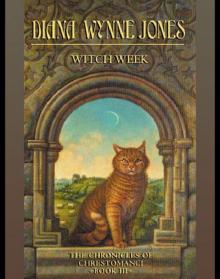 Witch Week
Witch Week Year of the Griffin
Year of the Griffin Wild Robert
Wild Robert Earwig and the Witch
Earwig and the Witch Witch's Business
Witch's Business Dogsbody
Dogsbody Caribbean Cruising
Caribbean Cruising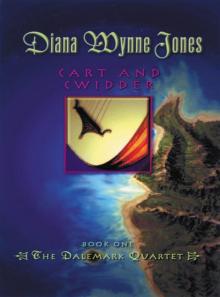 Cart and Cwidder
Cart and Cwidder Conrad's Fate
Conrad's Fate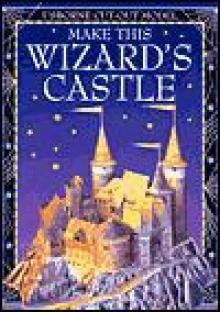 Howl's Moving Castle
Howl's Moving Castle The Spellcoats
The Spellcoats The Pinhoe Egg
The Pinhoe Egg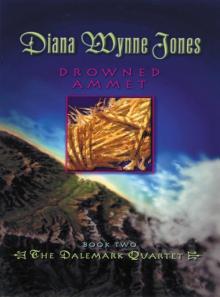 Drowned Ammet
Drowned Ammet The Ogre Downstairs
The Ogre Downstairs Dark Lord of Derkholm
Dark Lord of Derkholm Castle in the Air
Castle in the Air The Magicians of Caprona
The Magicians of Caprona A Tale of Time City
A Tale of Time City The Lives of Christopher Chant
The Lives of Christopher Chant The Magicians of Caprona (UK)
The Magicians of Caprona (UK)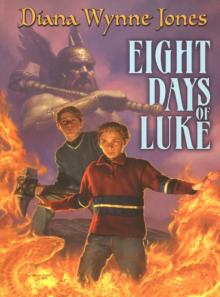 Eight Days of Luke
Eight Days of Luke Conrad's Fate (UK)
Conrad's Fate (UK)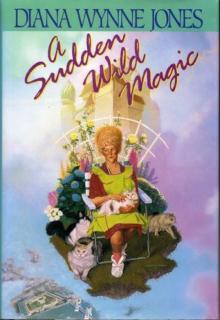 A Sudden Wild Magic
A Sudden Wild Magic Mixed Magics (UK)
Mixed Magics (UK) House of Many Ways
House of Many Ways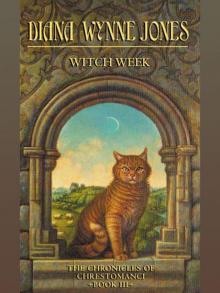 Witch Week (UK)
Witch Week (UK) The Homeward Bounders
The Homeward Bounders The Merlin Conspiracy
The Merlin Conspiracy The Pinhoe Egg (UK)
The Pinhoe Egg (UK) The Time of the Ghost
The Time of the Ghost Hexwood
Hexwood Enchanted Glass
Enchanted Glass The Crown of Dalemark (UK)
The Crown of Dalemark (UK)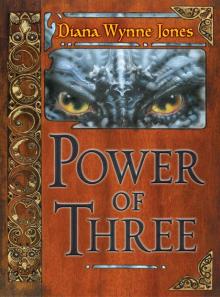 Power of Three
Power of Three Charmed Life (UK)
Charmed Life (UK) Black Maria
Black Maria The Islands of Chaldea
The Islands of Chaldea Cart and Cwidder (UK)
Cart and Cwidder (UK) Drowned Ammet (UK)
Drowned Ammet (UK) Charmed Life
Charmed Life The Spellcoats (UK)
The Spellcoats (UK) Believing Is Seeing
Believing Is Seeing Samantha's Diary
Samantha's Diary Aunt Maria
Aunt Maria Vile Visitors
Vile Visitors Stopping for a Spell
Stopping for a Spell Freaky Families
Freaky Families Unexpected Magic
Unexpected Magic Reflections
Reflections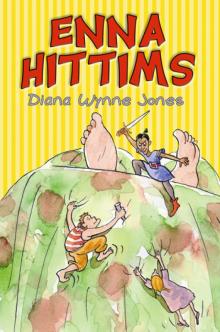 Enna Hittms
Enna Hittms Mixed Magics: Four Tales of Chrestomanci
Mixed Magics: Four Tales of Chrestomanci